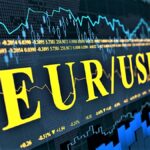EURUSD Surges to 3.5-Year High as Trump Targets Fed Chair Powell, Threatening Dollar Stability.
EURUSD pair kicked off the week with a strong rally, pushing beyond the 1.1575 mark—levels not seen in more than three years. Investors dumped the US Dollar following an alarming political development that threatens the credibility of the world’s most powerful central bank.
The US Dollar Index (DXY), which tracks the performance of the Greenback against a basket of major currencies, nosedived to a three-year low near the 98.00 threshold. The plunge follows bombshell comments from US President Donald Trump, who expressed his intent to fire Federal Reserve Chair Jerome Powell for not aggressively slashing interest rates.
The Euro, in contrast, found strength despite growing expectations for further rate cuts by the European Central Bank (ECB) in June. This unusual divergence reflects mounting skepticism over the USD’s safe-haven status rather than a renewed vote of confidence in the Eurozone.
Trump’s Attack on the Fed Undermines USD’s Global Standing
In a move that stunned financial markets, President Trump declared that Powell had failed the American people by not lowering interest rates, despite falling oil and food prices. “The Fed really owes it to the American people to get interest rates down. That’s the only thing he’s good for,” Trump said Friday. He further added, “If I want him out of there, he’ll be out real fast, believe me.”
The comments sent shockwaves through global markets as they reopened on Monday. Doubts surrounding the Fed’s independence—long considered a bedrock of US monetary credibility—spooked investors. Historically, political interference in central banks has led to volatile markets, capital flight, and long-term damage to currency strength.
Further stoking fears, White House economic adviser Kevin Hassett confirmed that the administration is exploring legal options to remove Powell. “The President and his team will continue to study that matter,” Hassett said, raising the stakes for a potential constitutional clash.
Fed Voices Push Back: “Monetary Independence Is Non-Negotiable”
Reacting swiftly, Chicago Fed President Austan Goolsbee emphasized the importance of monetary independence during an interview with CBS’s Face the Nation. “We should not move ourselves into an environment where monetary independence is in question,” Goolsbee warned, adding that undermining the Fed’s autonomy could erode confidence in US economic leadership.
Economists globally echoed similar sentiments. A consensus holds that countries with politically independent central banks typically deliver better macroeconomic outcomes, including lower inflation volatility, more stable growth, and stronger investor trust.
Markets are already pricing in increased volatility amid concerns that Trump’s rhetoric might lead to policy missteps or hasty rate cuts—decisions that could backfire in the long run.
Despite Dovish ECB, Euro Finds Support
Ironically, while the US Dollar tumbles on questions of credibility, the Euro is rallying despite growing bets that the ECB will ease policy again in June. Traders now price in a 75% probability of another rate cut, up from 60% last week, according to Reuters.
This expectation follows the ECB’s move last Thursday to cut its key interest rates by another 25 basis points, marking the seventh reduction in its current easing cycle. ECB President Christine Lagarde struck a cautious tone, stating that “economic outlook is clouded by uncertainty as trade disruptions would weigh on business investment.”
Interestingly, the ECB also omitted its usual line that policy rates remain “restrictive,” potentially signaling that the aggressive phase of its easing cycle is nearing an end.
Despite the dovish backdrop, the Euro’s resilience stems from relative policy stability and ongoing progress in US-EU trade talks. Notably, the EU is considering adjusting methane emissions rules, potentially clearing regulatory hurdles for US natural gas exports to Europe—an olive branch that could smooth transatlantic relations.
What Does This Mean for Forex Traders?
The EURUSD breakout marks a significant technical and psychological shift in the currency markets. The 1.1500 level, which previously acted as strong resistance, has been decisively breached, opening the door for further upside. With the DXY under pressure and Fed independence under question, forex traders are likely to continue favoring the Euro—at least in the short term.
From a risk perspective, traders should remain alert to:
1. Legal developments around Powell’s position: Any move by the White House to formally dismiss Powell could lead to a USD panic.
2. Statements from other Fed officials: Further affirmations of independence could provide limited USD support.
3. ECB commentary: If ECB officials signal a pause in the easing cycle, the Euro could get another leg up.
4. Trade negotiations: Positive headlines from US-EU discussions might bolster the Euro further.
Technical Analysis: EURUSD Turns Bullish on All Fronts
From a technical standpoint, the EUR/USD pair has broken through its 200-week moving average and key resistance at 1.1500, confirming a bullish reversal pattern that began forming in Q1.
Immediate resistance: 1.1625 (early 2021 highs)
Support zone: 1.1500–1.1470 (previous resistance turned support)
Momentum indicators: RSI signals overbought conditions, but bullish divergence supports continuation.
Unless a strong catalyst reverses the current USD bearish sentiment, EUR/USD could target the 1.1800 zone in the coming weeks.
Geopolitical Risks Reinforce EUR Strength
Beyond rate dynamics, geopolitical risks are also feeding into the EUR/USD narrative. Markets remain wary of Trump’s broader trade policies, which have become increasingly erratic and unpredictable. Investors fear that retaliatory moves from other economies or escalations in tariff battles could damage US export competitiveness—further weighing on the dollar.
Additionally, the European Union’s efforts to diversify energy imports and regulatory frameworks are seen as a step toward economic self-reliance, supporting the Euro’s long-term appeal.
Conclusion: EURUSD Rally Reflects Deepening Dollar Troubles
The sharp appreciation in EURUSD is less about Euro strength and more about collapsing confidence in the US Dollar. President Trump’s direct threats to remove the Fed Chair have triggered alarm bells across financial markets. The idea that the Federal Reserve might be subject to political whims is an existential threat to its role as the world’s most influential central bank.
Meanwhile, the ECB’s cautious approach, along with stable EU policymaking and progress in trade relations, gives the Euro a relative edge. Unless there is swift clarification from the White House or a calming intervention by senior Fed officials, the USD may remain under pressure—with EURUSD likely to climb higher.
Why is the EURUSD rising despite ECB dovishness?
Can President Trump actually fire Fed Chair Jerome Powell?
How does Fed independence impact the US Dollar?
What are the key levels to watch in EURUSD?







